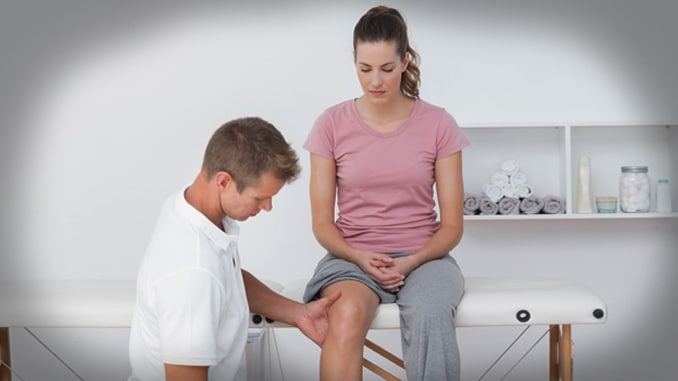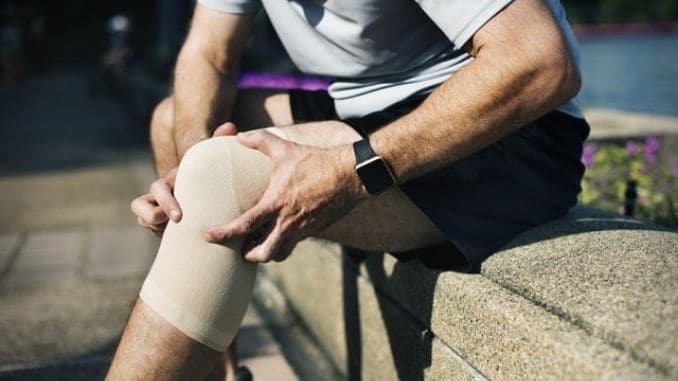
We’ve long been told that daily baby aspirin can help protect us from cardiovascular disease and perhaps even cancer. A recent study, however, showed that even at such a low dose, long-term use of aspirin can be harmful, increasing the risk of gastric bleeding, particularly in older people.
As we learn more about the risks of taking over-the-counter pain relievers, we understand the importance of finding other methods of pain relief. Aspirin, ibuprofen and other non-steroidal anti-inflammatory drugs (NSAIDS) are effective, but they can cause damage over time.
Fortunately, there are other tools that can help ease joint pain and stiffness.
1. Heating Pad
This is an oldie but goody when it comes to easing joint pain and stiffness. The heat helps relax tight muscles, and that eases pressure on the joint, reducing pain. It can also help ease morning stiffness if you use it for a few minutes before getting out of bed or immediately after.
If you come home after a long, active day, or if you need relief from pain and stress, plug in your heating pad and apply it to the affected area for 20 minutes or so. Make sure to protect skin with a soft cloth to avoid burns.
2. Hot Bath, Shower or Hot Tub
Whereas a heating pad is effective, hot water can be even more helpful. In a 2006 study, researchers found that soaking in hot water for 20 minutes a day, five days a week for two weeks improved symptoms of arthritis of the knee.
Warm water loosens joints, relaxes muscles, and eases the pain, with effects that last up to an hour or longer. Because water reduces the forces of gravity on the joints, it helps decrease swelling and inflammation while increasing circulation. The Arthritis Foundation recommends doing some gentle stretching while you’re in the water. You can also place a tennis ball between the small of your back and the back of the tub, and then roll it against knotted muscles to ease tightness and knots.
3. Warm Paraffin Wax Treatment
The increase in the use of keyboards on computers, tablets, and smartphones has made hand and finger joint pain even more common. One of the best ways to relieve this type of pain is to use a paraffin bath. Paraffin wax can absorb and retain heat, and to then transfer it efficiently to the affected area. It’s also able to penetrate more deeply into the joint, which can make it more effective than other sorts of heat treatment.
In a 2013 study, participants who used the paraffin wax bath on their painful hands experienced more pain relief and improvements in range of motion than those who used only joint mobilization exercises. In a 2014 study, researchers found that combining paraffin wax baths with exercises had a faster pain-relieving effect than exercises alone, with both treatments improving hand and finger grip strength.
Not only can a paraffin bath soothe joint pain, relax stiff muscles, and increase the range of motion, but it can also help treat dry skin — an added benefit during the winter. The wax is a natural moisturizer and leaves skin smooth and soft.
4. Capsaicin Creams or Gels
These products contain capsaicin, which is the same chemical that makes cayenne pepper hot. It works by irritating the nerve endings in the skin, which causes the body to respond by reducing pain signals in the nervous system. In a 2014 review of five studies, researchers found that topical treatment four times daily was moderately effective at reducing pain up to 20 weeks, regardless of where the treatment was used, such as for a knee, wrist or shoulder.
Capsaicin creams and gels are inexpensive and easily found at your corner drug store or pharmacy. They work best for temporary relief of both muscle and joint pain that feels close to the surface of the skin.
5. Hand Exercisers
Speaking of hand pain, another way to help keep it at bay is to exercise the hands and fingers regularly. Hand exercisers comfortably fit in your hand and are meant to be gripped and released repeatedly to help develop strength. Using them regularly has been shown to help improve function in arthritic hands.
In a 2015 study, researchers found that participants with rheumatoid arthritis who performed hand exercises daily for 10 to 15 minutes during a period of 12 weeks experienced double the effective treatment of usual care. The exercises also helped improve participants’ daily activities.
You can find hand exercisers easily at your pharmacy, medical shop or online. They come in a variety of sizes and resistance strengths. Choose those that fit your hand size, then start easy and gradually work up to the more resistant ones. Some can also be heated or cooled to provide relief while you’re working with them.
6. Herbal Supplements
Although it’s important to be sure you’re getting quality products from reputable brands, herbal supplements can be effective in relieving pain and stiffness. Some of the most common ones linked with pain relief include the following — always talk to your doctor before starting a new supplement.
Boswellia
Also known as Indian frankincense, Boswellia products usually include the gum resin that comes from the Boswellia serrata tree, which is native to India. It’s been used for centuries to treat pain, but now research has also discovered that it can be very effective against joint pain.
Boswellia contains antioxidant compounds that may help inhibit pro-inflammatory enzymes that cause pain and swelling. It may also help prevent cartilage loss and inhibit the destructive autoimmune process of rheumatoid arthritis.
In one 2004 study, researchers found that a daily supplement of 333 milligrams of Boswellia reduced knee pain and improved mobility better than a placebo. Other studies have found that when combined with curcumin — which comes from turmeric — the effects may be even greater.
Turmeric
In a recent 2018 study, researchers tested a turmeric treatment against combined turmeric and Boswellia treatment in patients with osteoarthritis. Results showed that after three months, both worked better than a placebo, but the combined treatment was more effective in reducing pain and improving physical performance.
Turmeric is a yellow-colored powder ground from the root of the turmeric plant. It contains a chemical called “curcumin” that helps reduce pain and inflammation. Curcumin blocks inflammatory agents like the Cox-2 enzyme, which is the same way that the pain reliever Celebrex works. Several studies have shown that turmeric helps reduce pain and improve function in patients with arthritis.
Devil’s Claw
This is a plant native to South Africa, and it’s the root that has therapeutic properties. It contains harpagoside, which is an active ingredient that seems to reduce pain and inflammation in joints. Several laboratory and animal studies have shown this herb to be effective against inflammation, and some small human studies have shown that it may help with arthritis.
In a 2000 study on about 122 patients with osteoarthritis of the knee, researchers found that about 2,600 milligrams of devil’s claw a day could be as effective at reducing joint pain as diacerein, a prescription medication for arthritis. In fact, patients using devil’s claw used significantly less over-the-counter pain relievers. They also experienced fewer side effects than those taking diacerein.
White Willow Bark
Also called “nature’s aspirin,” white willow bark comes from the willow tree, and contains the active ingredient salicin, which is the same active ingredient in aspirin. Because the salicin in willow bark converts to salicylic acid in the body, it may be gentler on the stomach than regular aspirin. High doses, however, may lead to side effects like stomach cramping and bleeding.
The herb also contains other flavonoids and plant chemicals that may contribute to its effectiveness. You can get it in a pill supplement — many products combine it with Boswellia and turmeric — or you can get white willow bark tea or even white willow bark topical cream.
Fish Oil (Omega-3 Fatty Acids)
Fatty fish like salmon and sardines are a good source of omega-3 fatty acids, which help relieve inflammation. The specific types found in fish oil include DHA (docosahexaenoic acid) and EPA (eicosapentaenoic acid). Several studies have linked these to reduced joint swelling and pain. One 2012 review also found that they helped improve morning stiffness.
People with rheumatoid arthritis may also benefit. In one 2016 study, researchers found that those who took a daily omega-3 fatty acid supplement improved so much that they were able to reduce their reliance on pain-relieving medications.
7. A Good Mattress
In a 2012 study, researchers analyzed the effects of sleep loss in participants with rheumatoid arthritis and in healthy controls. Results showed that while the healthy controls suffered from mood changes the next day, those with rheumatoid arthritis felt more tired, depressed, anxious and suffered more pain after not getting enough sleep. The researchers concluded that sleep loss activated rheumatoid arthritis-related joint pain.
Other research has shown that sleep deprivation increases levels of proinflammatory enzymes and the stress hormone cortisol, both of which can make joint pain worse.
That means sleep is particularly important for those with arthritis, but it’s not always easy to get, particularly if you’re experiencing pain. Poor quality mattresses that don’t support your body can disrupt your sleep, and leave you feeling worse in the morning than you did the night before.
If you regularly wake up in pain or feeling extra stiff, your mattress probably needs to be replaced. Most last only 5 to 8 years, so if you’ve had yours longer than that, it’s time to go shopping. Don’t worry — it’s not indulgent — it’s necessary. In a 2009 study, researchers found that participants who had mattresses older than five years who then tried new mattresses experienced significant improvements in sleep quality and pain, with continued improvement during a 4-week period.
You want to choose something that’s supportive, but not too hard. The mattress should conform to the curves of your body and help relieve pain overnight. Take your time testing out mattresses, and take a friend with you who can tell you whether you’re sinking into the bed too much or not.
When you’re ready to buy, make sure the store has a money-back guarantee. That way you can test the mattress in your home for 30 days or more to be sure it’s going to work for you. If it doesn’t, don’t hesitate to return it and try another. Your sleep is critical to your health and well-being, and to keep your pain under control.
If you want to overcome the aches and pains that have been keeping you from enjoying life, then check out the Joint Complex 4000, here!








